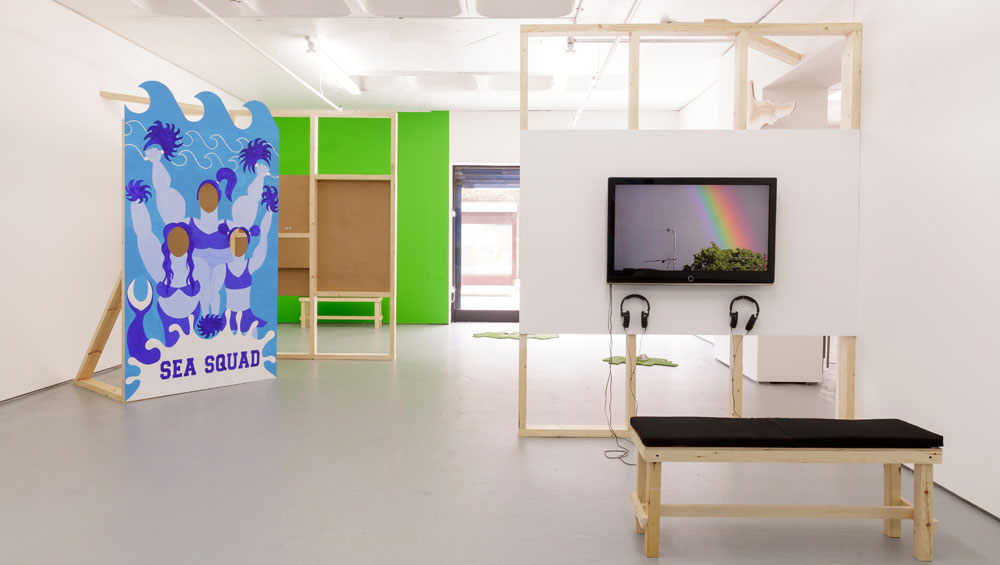
by HATTY NESTOR
How do we undermine dominant political and cultural narratives? Or rather, what circumstances enable platforms to reimagine how we question our placement within society through artistic practice? The exploration of political and societal issues is apparent in curator and artist Chris Alton’s group show You’re Surrounded by Me, funded by Arts Council England, and currently at Turf Projects, an artist-led space in Croydon, south London. Since graduating from Middlesex University in 2014, Alton has undertaken a series of artistic projects, most notably English Disco Lovers (2013), a satirical protest group that he founded, which subverted the meaning of the English Defence League’s abbreviation, as well as the etymology of the word disco, which derives from “discotheque”, a French word meaning “record library”.
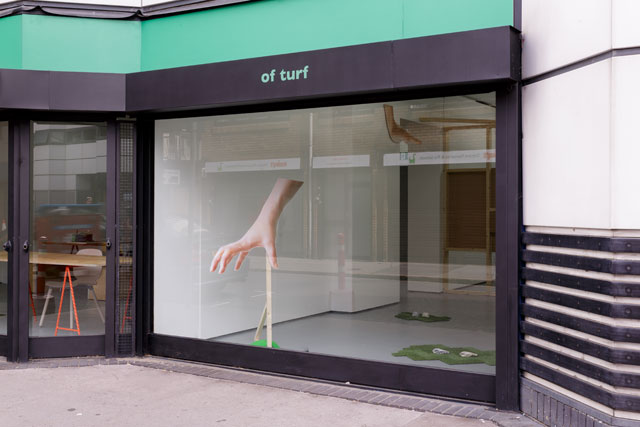
You’re Surrounded By Me, 2017. Installation view at Turf Projects, Croydon. Image courtesy of Tim Bowditch.
I meet Alton at Turf Projects, where an assemblage of video, installation and sculpture works poignantly weave together a meditation on contemporary issues such as climate change, the sea, protest and the subversion of heraldry. We talk about commons, video art, Donald Trump, and even golf. The five artists in the exhibition – Alton himself, Liam Geary Baulch, Naomi Fitzsimmons, Jasleen Kaur and Katherine Midgley – explore the dynamic relationship between a number of contemporary sociopolitical and conceptual topics in visual and linguistic material. The exhibition prompts important questions in relation to how we shed light not only on wider sociopolitical issues, but how, as individuals, we offer an alternative to the status quo in mainstream culture. The show is a tangible, visual reflection on the enigmatic relationship between the real and imaginary. Alton prefers collective and collaborative approaches to curating as opposed to refining predetermined sets of principles or ideas.
Often in group exhibitions the artworks exist autonomously; they all interlink and inform one another. However, in the current turbulent political climate, it is surely the purpose of art to bear witness to the ensuing precarity. In what Alton describes as “seeking to offer an alternative”, it is apparent that what this exhibition does goes beyond the materiality of the artwork itself: it suggests a dynamic understanding of how we can envision new ways of curating, while commenting on the political importance of love, humour, non-violence, collaboration and speculative futures.
Hatty Nestor: Do you see curating as a tool to bring different artists’ practices together?
Chris Alton: Absolutely. By bringing different artists and works together, there is the possibility to amplify particular political ideas and approaches. It’s about establishing these dialogues and lines of thought in order to see something new – something previously unseen in curatorial practice.
HN: With the rise of “alt-right” sentiment, the collective apathy felt in other areas of society can be problematic when trying to find new ways of defeating the politics of alienation. Is there a political reimagining underlying this show?
CA: That idea of trying to overcome or reimagine the way we discuss contemporary politics is definitely present. Many of the works manifest the desire to complicate or disrupt dominant cultural narratives. Naomi Fitzsimmons’s Ariane (2017) typifies this approach. Ariane focuses on a particular female stock-image model; the work discusses the nature of precarious work and the power dynamics inherent in the stock-image industry.
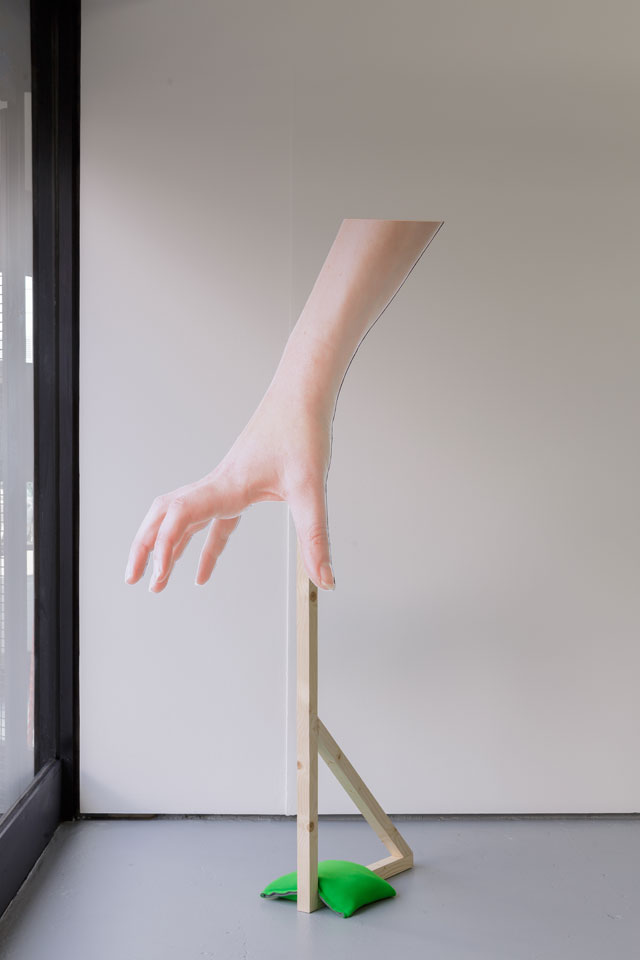
Naomi Fitzsimmons. Ariane, 2017. Digital print on plywood, timber, textiles. Image courtesy of Tim Bowditch.
HN: You are both an artist in the exhibition and its curator. Was this joint role an attempt to destabilise a sense of hierarchy?
CA: For me, being both an artist and a curator isn’t explicitly to do with addressing the hierarchy that exists between the two. By embodying both roles, I blur the line between the categories. Bringing together artists to create a context is a natural extension of my existing practice; working with other people to create dialogues and communities is a longstanding aspect of my work.
HN: Liam Geary Baulch’s piece, Sea Squad, incorporates the chant “I am the sea, you’re surrounded by me”, which blurs the lines between the natural and manmade world. The exhibition’s title also comes from this. How does the title reflect your intention as a curator?
CA: There is certainly an impulse to give voice to the unheard, which drives the show. Liam’s Sea Squadset me off down this path. I saw him perform it for the first time more than a year ago at Limbo, an artist-led project space in Bermondsey, south-east London. The driving idea behind the work is to give voice to the sea; to amplify something that is undeniably present yet ignored. The hook, “you’re surrounded by me”, resonated with me and became a point of departure for the political concerns and narratives throughout the exhibition.
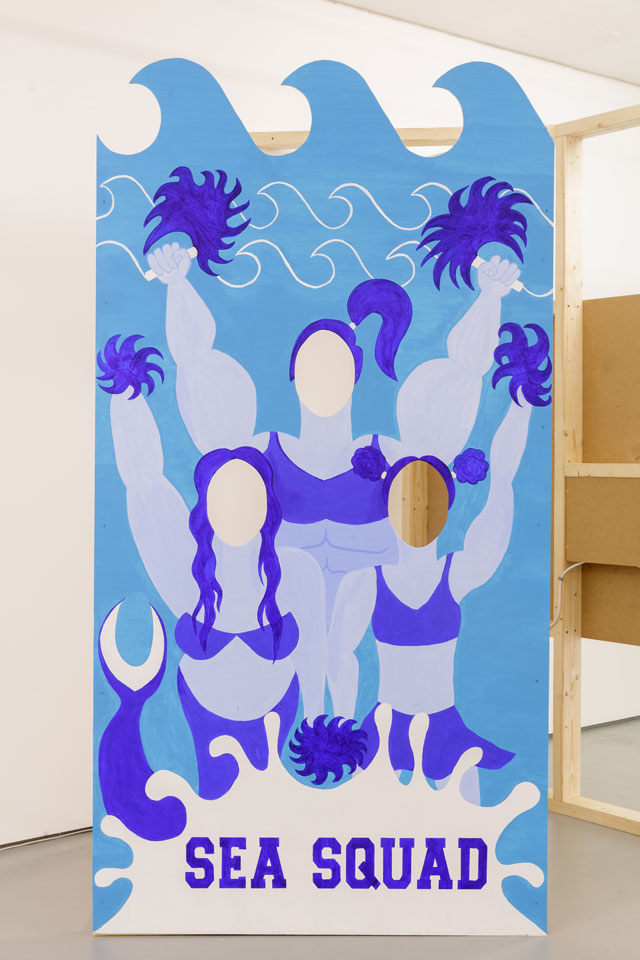
Liam Geary Baulch. Sea Squad, 2017. Acrylic paint on plywood, 230 x 120 cm. Image courtesy of Tim Bowditch.
The main challenge was how to put Sea Squad in a gallery space for a month and a half, when it had only previously existed as a performance. We decided to focus on things that allowed space for the viewer and invited them to join the Sea Squad. The peep board itself is incomplete without a degree of participation. We’ve also included a sports shirt hanging on the wall, a set of instructional diagrams and a video, which is akin to a recruitment ad.
HN: I also noticed in the video phrases such as “rising of the masses” and “uniformity gives us power”, which incorporate a political agenda while also referencing the sea. Does this suggest an idea of political collectivity?
CA: Yes, Liam is referencing how water works on a molecular level. In the dance routines, there are structural references to the water molecule; the heads of the peep board reference the atomic arrangement of hydrogen and oxygen. The H20 molecule is very unusual, as it forms hydrogen bonds. These are very rare and grant water a number of properties that few other molecules exhibit. Phenomena such as water cohesion and adhesion wouldn’t be possible without them; in short, hydrogen bonding means that water molecules can do incredible things by sticking together.
HN: Sea Squad also derives from climate change protests and non-violent forms of political activism. Does it exist in different spaces, aside from galleries?
CA: Liam comes from a background of non-violent protest and is one of the most committed activists I know. Sea Squad draws on his experience as a climate change activist and has re-entered those spheres. Sea Squad performed inside the British Museum in protest against BP – this was part of ongoing action against BP’s sponsorship of cultural institutions.
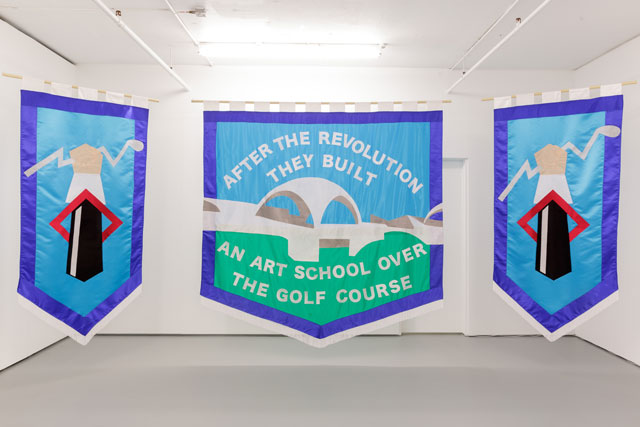
Chris Alton. After The Revolution They Built An Art School Over The Golf Course, 2017. Textiles, 215 x 105 cm, 225 x 220 cm, 215 x 105 cm. Image courtesy of Tim Bowditch.
HN: Your own work in the exhibition, After the Revolution They Built an Art School Over the Golf Course (2017), refers to the current political climate. On first encounter, the wall hangings are similar to those found in community buildings or churches. Was this intentional?
CA: It is fitting for them to call to mind that aesthetic. They are about collectivity and community over the individual and private space. As well as the community space or church aesthetic, they also seek to subvert medieval heraldry. The arm motif on the left- and right-hand banners has been appropriated from Donald Trump’s coat of arms, which he took, without permission, from the crest of Joseph Davies, the original owner of Mar-a-Lago (Trump’s golf resort). The hand previously held a spear, but I’ve replaced it with a broken golf club, whose zigzag shape refers to the graphing of land values. I have an interest in heraldry; in many cases it’s about tying one’s right to power to a historical precedent, a bit like the divine right of kings.
HN: Is your own work also concerned with imagining speculative, utopian and dystopian futures?
CA: Absolutely. My work frequently uses fictional narratives. Here, I’m redeploying a future of the past in a contemporary context: the text After the Revolution They Built an Art School Over the Golf Course is a direct reference to what happened after the Cuban revolution. Fidel Castro and Che Guevara built an art school over the golf course at the Havana Country Club. I think it’s an idea that remains pertinent.
HN: Golf courses inhabit large spaces, yet are used by very few people. Does this relate to the show’s underlying concern with dominant cultural and political histories of space and ownership?
CA: While Trump was a point of reference in the work, it’s not solely about him. There are broader concerns; he appears as a symptomatic stand-in. I was interested in the dynamic that existed between the golf course and the art school; the former, an elite, private space, which (like any members’ club) serves to further consolidate power; the latter, an (ideally) free space for critical thinking and shared knowledge. I think it’s important to be aware of, and to challenge, our received norms, in order to imagine otherwise. Golf courses exist, but what if they didn’t? How could that space be put better use?
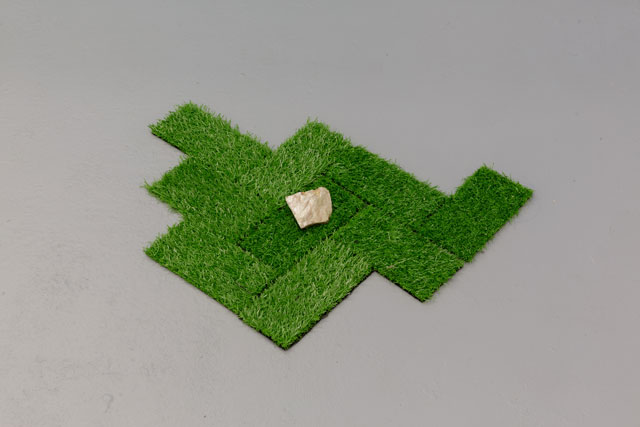
Jasleen Kaur. A thing that was a thing that was a thing, 2017. Porcelain kaolin rock, digital kaolin image, artificial grass. Image courtesy of Tim Bowditch.
HN: In front of your hanging textiles is a patch of false grass placed on the floor with a rock in the middle of it. Is there a reason the three grass islands named A thing that was a thing that was a thing aren’t exhibited next to one another?
CA: Yes. The work is question is by Jasleen Kaur. From a curatorial viewpoint, distributing them throughout the space allows relationships to be emphasised between this work and others. Placed in front of my banners, the patch of false grass could become part of the golf course and the stone a projectile of protest.
The idea of the “inauthentic” exists throughout Jasleen’s practice: it stems from having been brought up in “an Indian household, in Scotland, in the 90s”. Her family home was full of objects that were aesthetically aspirational; plaster mouldings in polystyrene, wood-effect vinyl and other false surfaces. This artwork builds on this interest. The object in the middle of the false grass appears to be a stone, but it’s really a fabrication. The materiality of the stone is more complex than it first appears. The form comes from Chinese kaolin, a mineral from which porcelain is derived, while the stone form is Chinese porcelain; and the outer layer is a digital image of British kaolin, all sourced from Google.
HN: Does this reflect the overlapping of cultural identities in relation to her heritage?
CA: Possibly. She has an interest in the hierarchy that exists between the fake and the real, and the notion of authenticity is something she has often interrogated. She frequently uses methods of layering or splicing when creating her works. This piece addresses wider and less directly personal narratives, although the dynamic of fake v real remains present. For A thing that was a thing that was a thing, Jasleen has created an object that emerged from her research regarding the history of porcelain production. These multilayered objects draw on historical attempts by British ceramicists to emulate Chinese porcelain. Ultimately, they managed to produce a version called hard-paste porcelain. The work acknowledges this crossover and the inherent complexity of cultures in dialogue.
HN: Naomi Fitzsimmons’s Ariane seems to approach how we, especially women, claim our bodies – stock images play throughout the video, and it seems the protagonist is comparing herself to the figures in the photographs. Towards the end, we see a number of women in a photography studio posing in a similar manner to the stock images. Is there a comparison being made between Ariane and the artist herself?
CA: Yes, or to flip your question on its head, how others claim women’s bodies. The film follows Naomi’s attempts to contact a ubiquitous stock-image model, known to online communities as Ariane. She begins with more conventional methods, such as searching online for contact details. However, as the film progresses, her attempts to contact Ariane become more and more absurd; at one point, she even stages a casting call for someone to play the part of Ariane. During interviews with the various women who attend, it becomes apparent that many of them have done stock-image model work. As they speak, they begin to reveal the reality that resides behind glossy stock images. In the broadest terms, the film is about precarious work, the effective entanglement of image and identity, and the nature of images in the digital age.
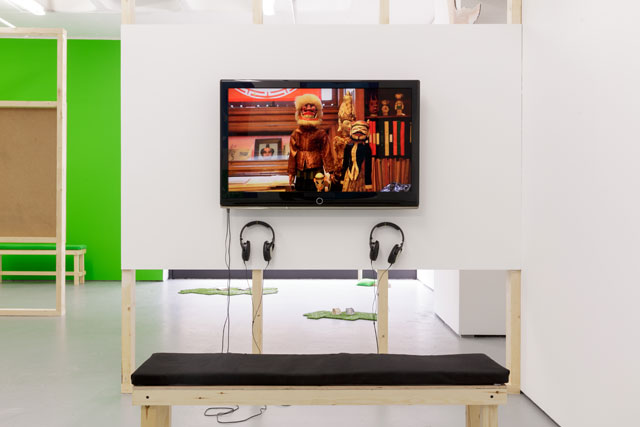
Katherine Midgley. Yesterday you are four pizzas, 2017. Video with sound, 11 min 30 sec. Image courtesy of Tim Bowditch.
HN: This relationship to the digital age is interesting. In Katherine Midgley’s film, Yesterday you ate four pizzas (2017), we see scenes of Glasgow: residential areas and the city centre, and puppets alongside an eerie narration. The film feels quite unedited, was this the artist’s intention?
CA: There’s definitely a feeling of wandering and collecting. Katherine filmed daily for several weeks, capturing hours of material, which was then edited down in relation to the script. The majority of the footage will come from chance encounters in her day-to-day life. I think the style of editing mirrors the feelings of disconnectedness that she discusses throughout the voiceover; in the world of the film, things feel strained, as if they’re barely holding together.
HN: It feels like a stream of consciousness, which reminded me of how, in comedy, often the protagonist will announce what they are doing as a catalyst to become self-critical, which ties into ideas surrounding performing the self. Is this a tool in the work to deal with the effects of therapeutic capitalism?
CA: Perhaps. There are a number of moments in the film when Katherine addresses the widespread commodification of every facet of our lives. The film explicitly mentions an app called Headspace, which monetises human emotions and wellbeing. More broadly, the work presents a dystopian and not-so-distant vision of the future, peppered with apathy. However, I get the sense that she’s looking for a way out.
HN: The music has a strange eerie quality, and feels quite apathetic, which is very reflective of the current political climate. It can feel confusing deciding where to situate oneself.
CA: She has distilled the sense of feeling displaced but also yearning for something. There’s a melancholic quality to the music, which feels uncertain. It’s like the whistling of wind through the void in the centre of a tube; the product of a negative space, an absence. It’s a work that couldn’t have been made at any other time. All the works in the show address the moment that we are living in. They attempt to address some of the issues that we face, while offering tools and suggesting alternative ways to thinking through the impasse. I hope that these ideas and methodologies resonate with people and are propagated, so that they can have a life beyond the gallery walls.
• You’re Surrounded by Me, curated by Chris Alton, is at Turf Projects, Croydon, until 9 September 2017.